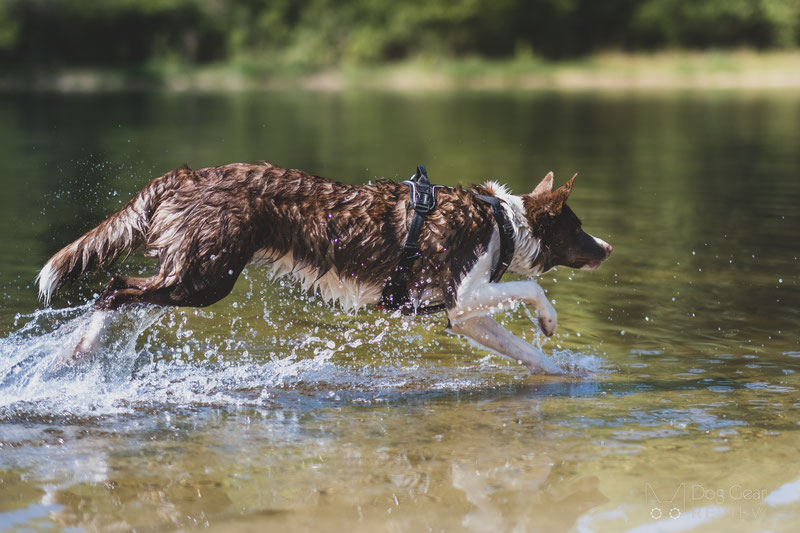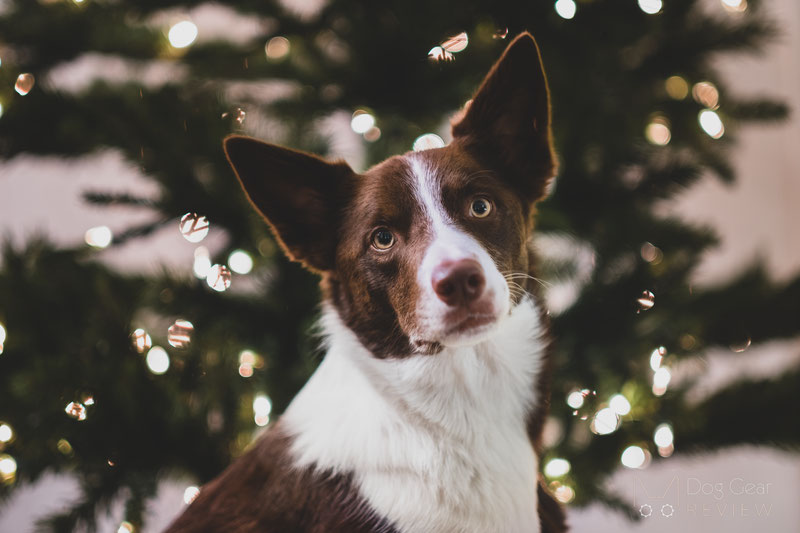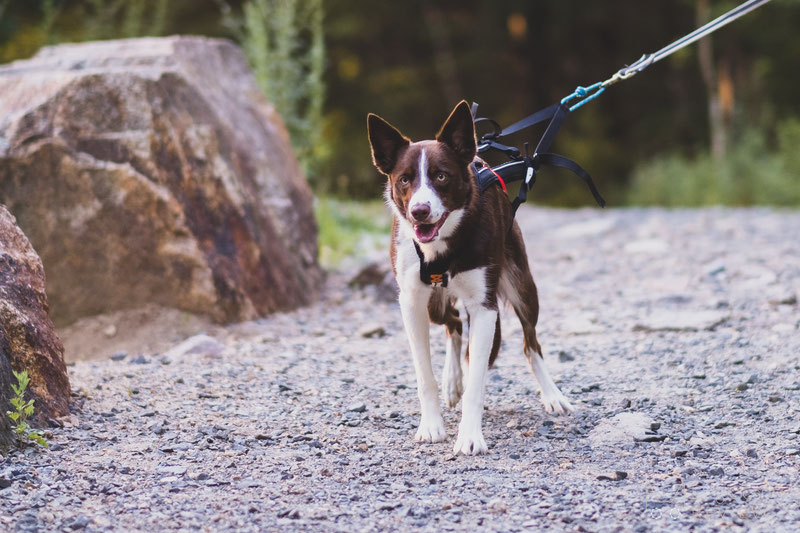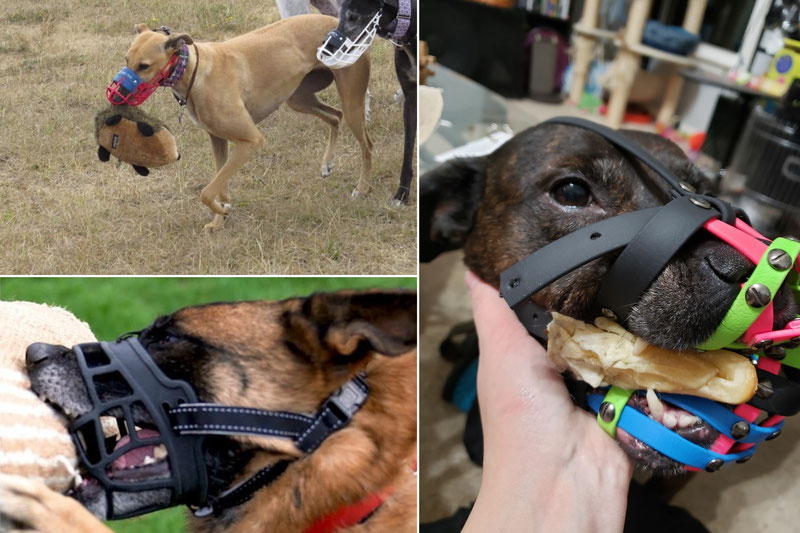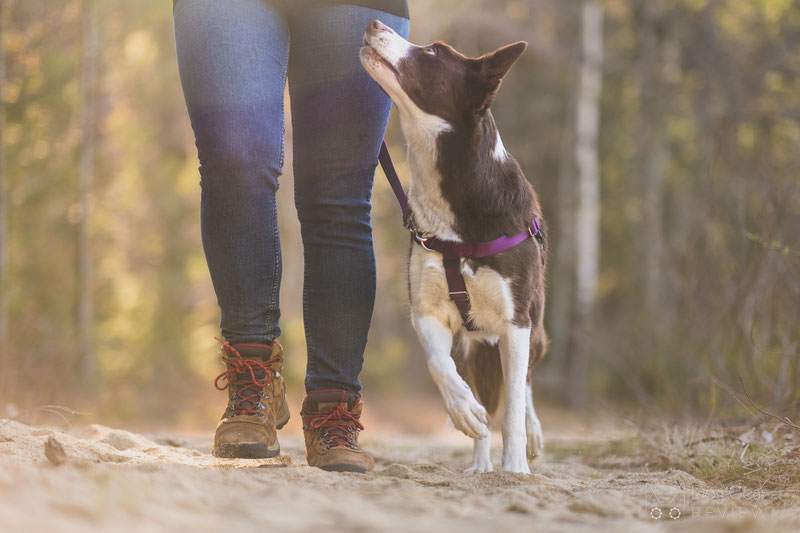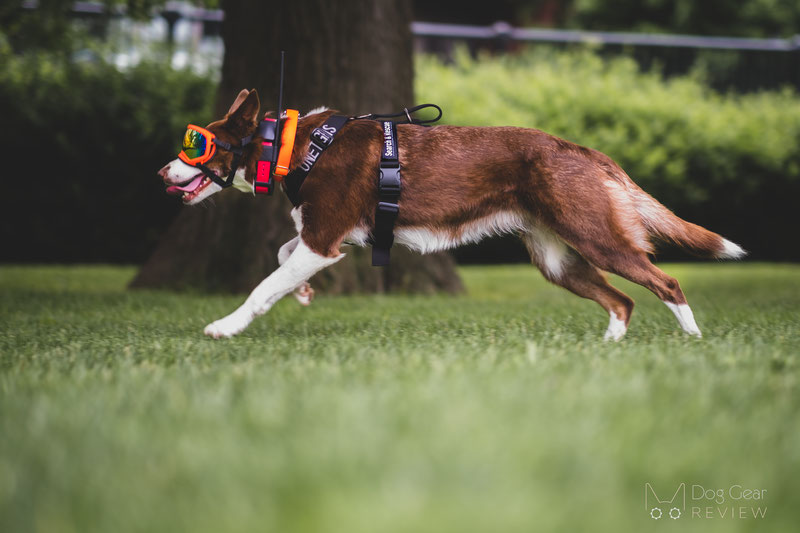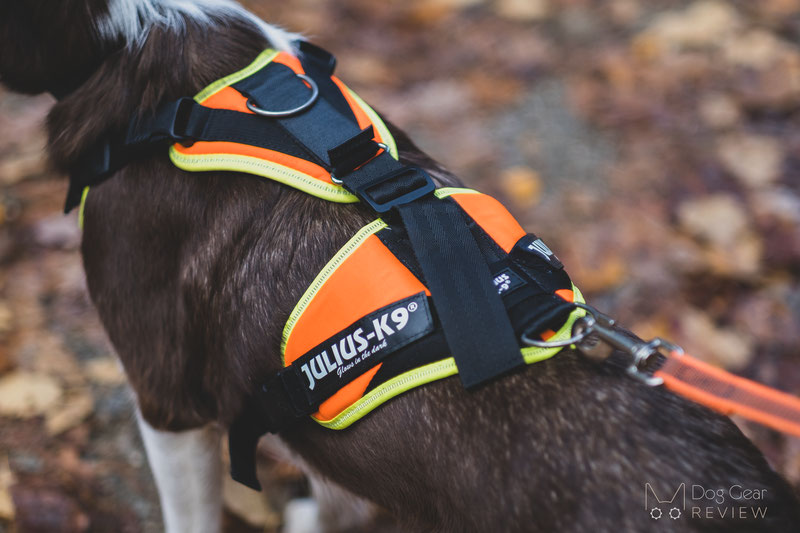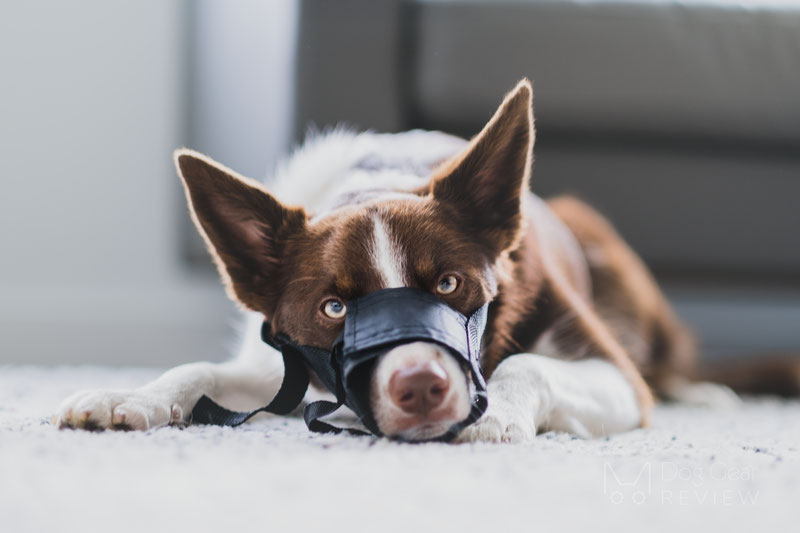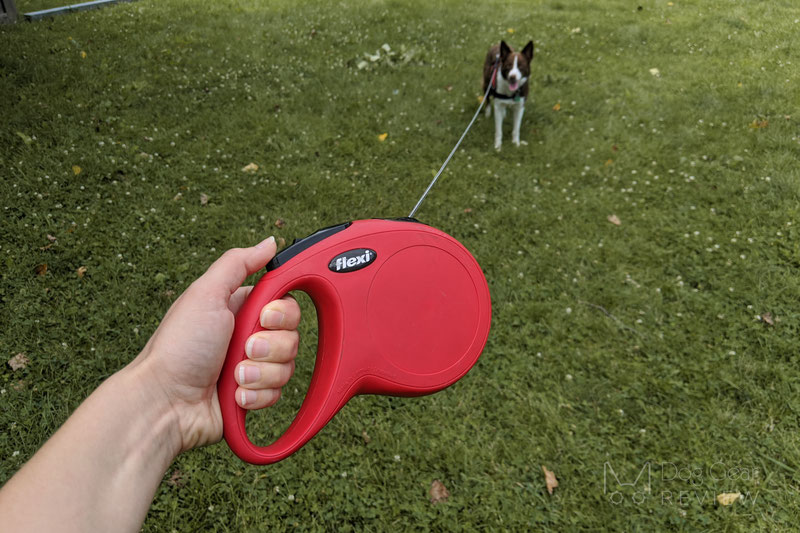Are you wondering how to help your dog enjoy the summer months? Debating between a cooling mat, a cooling vest, a car shade or a cooling harness? Do these actually work? We tested different cooling products and are ready to introduce the pros and cons of each category! ;)
Why would a dog need help cooling down?
I hear from many owners that wolves or hunting/guarding/herding dogs never needed a colling vest or a cooling mat, and they were all fine, so all these products are just the result of the “dog mom culture.”
Well, if you think about it, there are many differences in our dogs’ lives these days compared to even a few hundred years ago. First of all, dogs used to live outside 24/7, so they had weeks/months to get used to the weather warming up at the beginning of the season. These days, most family pets spend most of their time in an airconditioned or at least a somewhat temperature-controlled environment, so it’s much harder for them to handle the heat when they go out.
Another difference is that traditional working dogs used to sleep through the hottest part of the day - preferably in a hole dug under a bush - and they didn’t venture out unless there was something worth checking out. These days we might have to take the dogs for a quick walk in our lunch break, or we take them with us for a vacation to a sunny beach, or they sit with us on a boat/SUP in the sun. There are also service dogs and working dogs who need to work even when it’s hot, and their owner can’t choose to only walk them early in the morning and late at night when it’s cooler.
There are also many widely different breeds with very different needs and limitations. Originally dogs were bred for practical reasons, but as we all know, in the modern ages, most breeds were more bred for looks which took them far from those original working dogs/wolves.
Dogs are involved in our lives in very different ways than they used to, and many of them need some help to adjust to the situations we put them in. Does that mean that all dogs need a cooling vest/cooling mat or another cooling product? Absolutely not, but learning about these products and knowing when and how to use them can save many dogs’ lives.
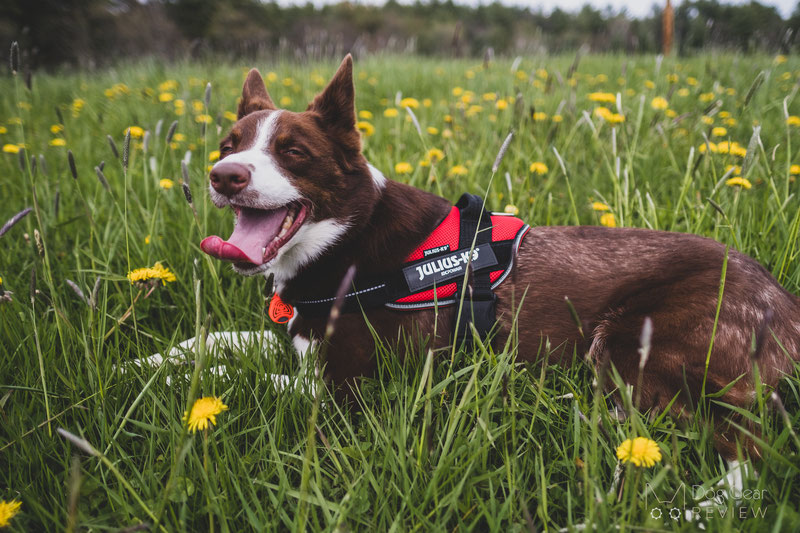
Limitations of all dog cooling products
It would be great if we could buy something and we wouldn’t need to worry about our dogs overheating at all, but unfortunately, this is not the case. Stacking up cooling beds, cooling vests, fans, etc., can make our dogs’ lives much more comfortable, but having all these still doesn’t mean we can expect them not to have issues with the heat. There will be hot and humid days when you still need to stay home with your dog instead of going for that adventure that you planned. Likewise, having a shade covering the car and cooling products in the crate doesn’t mean you can park the car in the mall parking lot and don’t worry about the dogs while you spend hours shopping.
These products are here to help, but their effectiveness will be different for every dog, and the risk of overheating will also change if your dog gets older, gains some weight, or has health issues, or if the air humidity is changing. Even if you buy all available cooling products, your dog can still overheat. Overheating can be a life or death situation for dogs, and we have to keep in mind that none of these products can completely eliminate this risk on some days.
Another important disclaimer is that in this article, we talk about helping the dogs to STAY cool, not to bring down their temperature once they are already overheated. Being proactive and using some cooling solution BEFORE your dog is struggling is much safer and is more effective.

Where to (and not to) cool the dog
Dogs mainly cool on their paws and through panting but if we want to help them stay cool, cooling their chest area is the most effective because the blood flow around the heart ensures that the cooling effect will be circulated in all areas.
Different cooling techniques require different designs to be effective and safe. Cooling jackets that work mainly by reflecting the sun will need to cover as much of the back as possible. Evaporation cooling vests or ones that need to be placed in the fridge/freezer should cover mainly the chest area and ideally leave the main muscle groups and joints uncovered as much as possible if they apply significant cooling effect. Over cooling the shoulders, hips, and spine with ice-cold vests can lead to injuries and is uncomfortable for dogs who already have any joint pain.
Let’s look into the different cooling products we tested!
We will look into how each of these products works in general, what to keep in mind when choosing one, and highlight a product in each category that we tested.
The thermal camera
For this section, we used the Seek Thermal Compact Camera to check the thermal image of each product. This is not a high-end, professional system, so the actual temperatures displayed on the photos are usually 4-6 Celsius higher than in reality. These thermal images are good enough to show differences in one image, but not to compare the displayed temps between different photo sessions.
Cooling Mats
Dogs naturally look for a cooler surface to lay on when it’s hot, so providing a cooling mat is a great way to help them over the summer.
Many cooling beds are using some type of gel that you usually need to place in the freezer. These are great unless you have a dog who chews. Most of these use a non-toxic gel, but it’s still not good for your dog to swallow. Read the details on the package to figure out if it’s safe for the dog and keep an eye on it while the dog is using the bed.
Other beds/mats use ice which is a much safer solution around chewers. If you choose a mat with ice, be sure that there is some insulation/padding around the ice, so it doesn’t get overly cold for the dog. Just like when you need to apply ice on yourself - you want limited contact through a cloth or another insulating layer.

Over the last hot weeks, we tested the Hydro Triple-Layer Cooling Mat that we received from Clean Run. This mat uses a FlexiFreeze® Ice Sheet that contains 88 built-in ice cubes containing only water. Having separate cubes is excellent because if one would get poked, you don’t need to replace the whole cooling sheet; you still have plenty of other cubes for cooling. If you do need to replace the ice sheet, you can do that separately without buying a new mat.
The Triple-Layer means that there is insulation around the ice sheet: a closed-cell foam on the bottom and a waterbed cushion on top. This ensures that the cooling effect can last for hours and that the mat’s top doesn’t get uncomfortably cold. Another feature of the mat is that it has snaps on three sides, so you can combine multiple of these to cover the area you need. The one that you see under Mia is a Single Mat size (18"W x 23"L x 1.25"H). This size is a little too small for Mia to lie on entirely, but at least this lets her move away from the mat in the car crate if it would be uncomfortable. When using a cooling mat in a crate, it’s ideal to allow the dog to move away from the cold if they had enough.
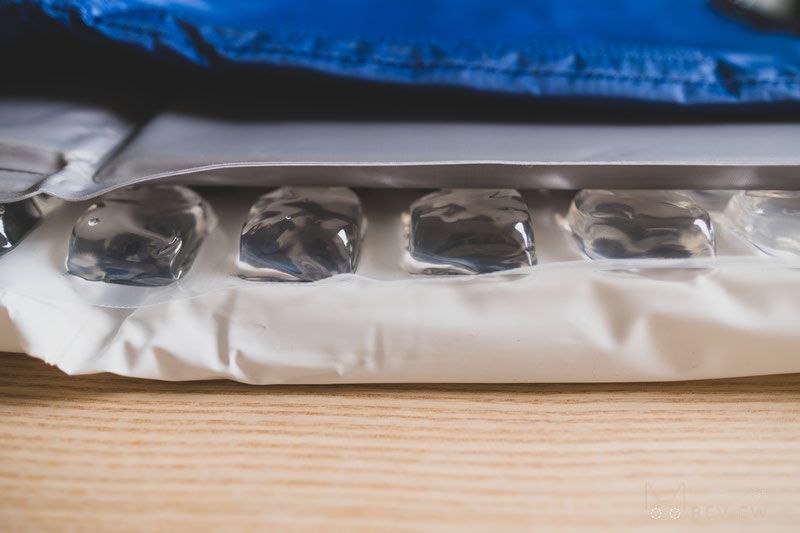
We used this mat during our search and rescue training days when Mia waited in the car. She was first unsure about the more slippery surface but decided to utilize it eventually. The top of the mat was still comfortably cool to the touch after hours of use in the car, but it didn’t feel ice-cold to begin with. This is exactly what I want from a cooling mat.
The photos below show the mat through a thermal camera after 2-hours of use. The actual measurements are inaccurate, so don’t look at the numbers, but the images show that the bed is significantly cooler than the environment.
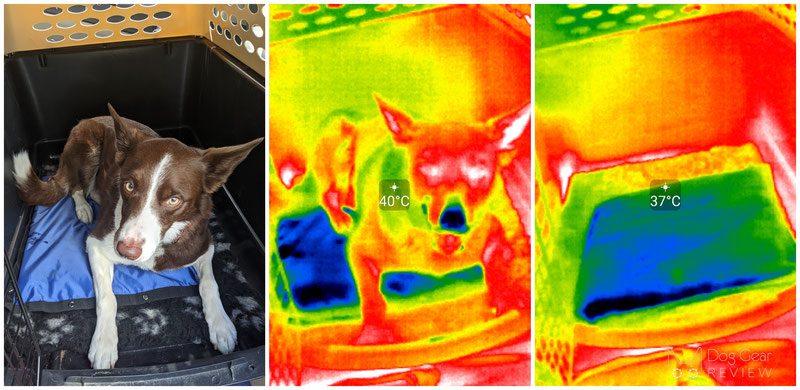
“Self-Cooling” Beds/Blankets
These so-called “Self-Cooling” technologies are based on using materials that are great in absorbing and releasing body heat. They don’t have an active cooling effect, there is no water or gel involved, but the surface feels cool to the touch, making it more comfortable for the dog. To be clear, when checked with the thermal camera, there is no difference in the surface temperature of the bed vs. its environment, but it does FEEL cooler.
We received the Premium Pet Cooling Blanket from Petfusion, which works this way. It is a thick blanket that you can put on a bed or use as a standalone mat. It will not provide a strong cooling effect as a bed with gel/ice, but in return, you don’t need to put it in the freezer or prepare it anyway. It eventually warms up under the dog, but the surface does feel surprisingly cool, which made Mia enjoy her memory foam bed again, even on hot days!
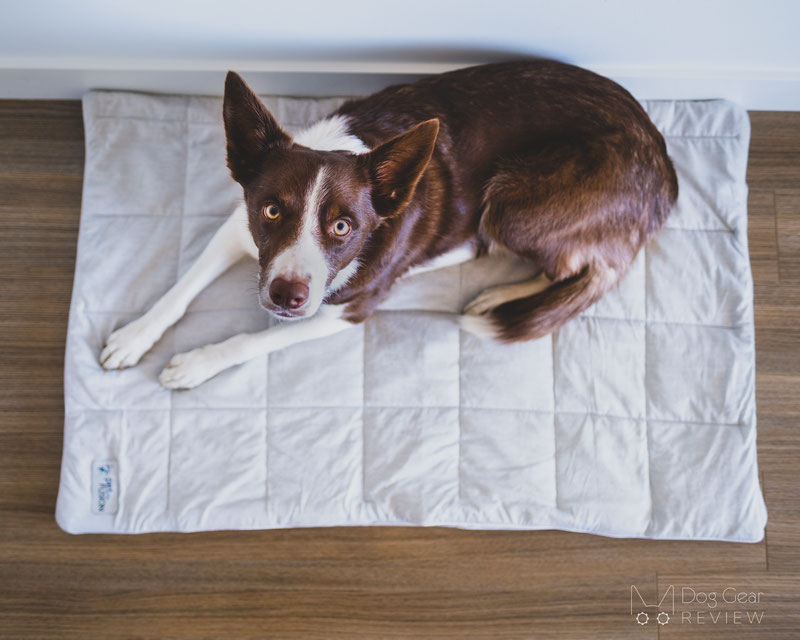
If you want to learn more about the Petfusion Premium Cooling Blanket, you can check out our detailed review for more information!
Evaporative Cooling Vests
These vests work by creating a big surface for evaporation. Evaporation-based vests utilize the same process when humans sweat to cool down. When the water changes from liquid to a gaseous state, it pulls energy from its surroundings, creating a small temperature drop. Cooling vests are made from different materials to retain the added water better and accelerate the evaporation process.
You could achieve the same effect if you soak the dog before heading out for a walk, but wet fur can cause rubbing and hot spots on long-haired, double-coated dogs, while short/thin-haired dogs dry too fast for this to be effective over a longer period. I always carry plenty of water when hiking with Mia, but it can be hard to effectively pour it on a double-coated dog. Most of the water poured on the coat usually just repels Mia, and half an hour later, she is dry again. This makes applying water directly on the dog very ineffective and unrealistic if you hike and would need to carry all that extra water.
A cooling vest makes applying water much easier and more effective while it provides a longer-lasting cooling effect without soaking the dog. The disadvantage of this method is that evaporation is only effective when the air is dry. On a humid day, the evaporation will be very slow or even non-existent, so instead of cooling the dog with the vest, they just have an extra wet layer on. On the other hand, if the air is dry, the evaporation process will be speedy, and the cooling vest might over cools the dog first then dries entirely soon after.
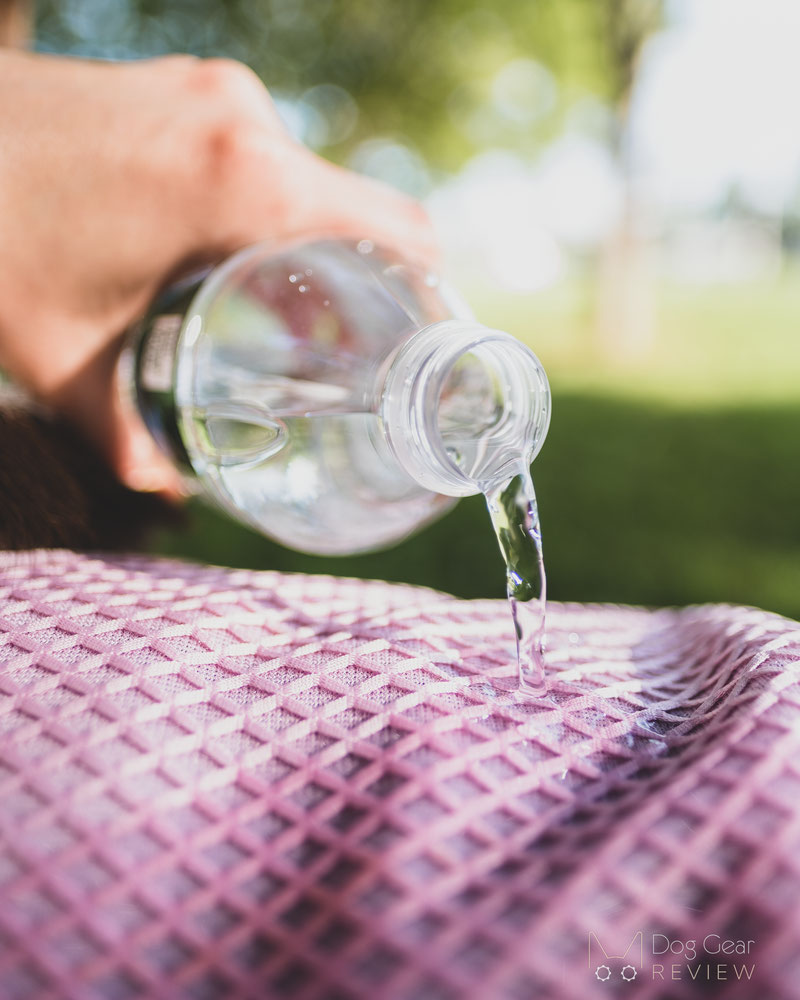
We started testing the Hurtta Cooling Wrap a few weeks ago, and it already came in handy during a few heatwaves. This Wrap makes applying water much easier and dries much slower than Mia’s hair. I was worried that she would get warm and dump under it, but she was comfortably cool when checking under the Wrap. As we discussed above, the drying time will significantly differ depending on the humidity of the air, wind, and sun, but this Wrap stayed wet for hours when we used it.
The Wrap is designed to cover the dog’s chest area, where they are the least insulated and are the easiest to cool. Many cooling vests cover mainly the dog’s back which is helpful when you want to reflect the sun, but it’s not ideal for cooling.
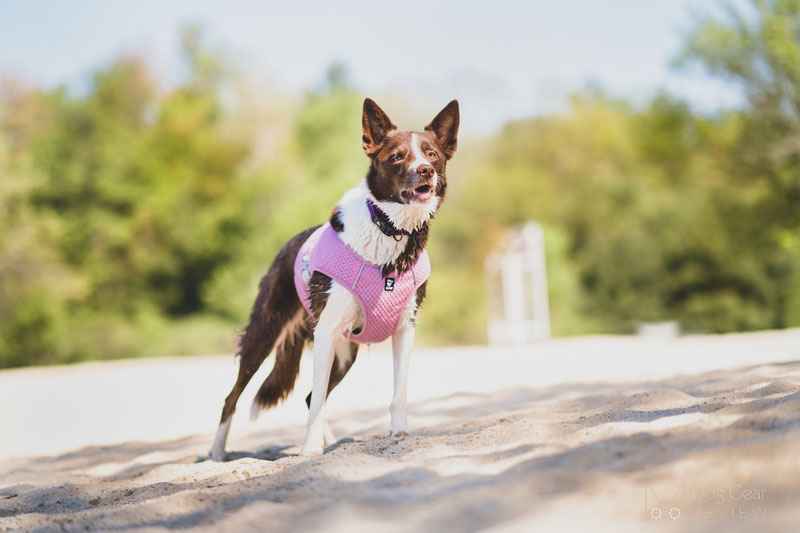
To objectively test the effectiveness of the Wrap, I took Mia for a half-hour walk on a hot day. At the beginning of the walk, I applied half a liter (~2 cups) of water to the Wrap, which absorbed quickly. After the walk, I removed the Wrap and took the attached photo with a thermal camera WITHOUT the Wrap. The fur under the vest wasn’t completely dry but wasn’t dump either, and it was significantly cooler than the other areas. As you see in the photo, “cooler” means that her fur’s surface temperature was close to the temperature of the grass in the shade, so we are not talking about overcooling the dog’s shoulder and chest area.
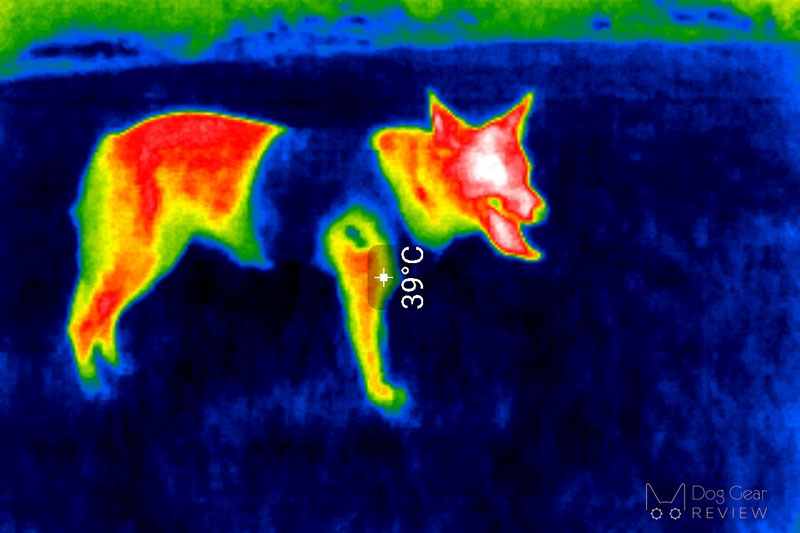
Although this thermal image still only shows the surface temperature on a double-coated dog, it confirms that it does work, and it’s fair to assume it somewhat helps them keep their temperature lower. It is impossible to tell upfront how much an evaporation vest would benefit a specific dog because it depends on many unique features. For example, while a Greyhound might be too cold under an evaporation vest, a Golden might not feel a big difference while wearing it. All I can say is that it seems to help Mia stay cool longer and cool down faster after a search task.
If you want to learn more about the Hurtta Cooling Wrap, you can check out our detailed review for more information!
Breathable/Cooling Harnesses
Using a dark harness with extensive coverage on the dog can significantly increase the dog’s body temperature over the summer because they both absorb the heat and trap the dog’s body heat under them. Many harnesses come with a mesh-like, breathable padded underside. This somewhat helps slow the warming under the harness by providing some airflow, but it still heats the dog altogether.
The Julius-K9 Powair Summer harness that we reviewed before used this mesh padding material for the whole harness making the harness light and airy. This material also makes adding water to the harness very easy, just like the Hurtta Cooling Wrap. The big difference in the cooling effect is that the harness only evaporates on the dog’s back, which is less effective. In return, this is still a strong harness that you can trust even for bigger dogs, while a cooling vest usually is not sturdy enough to be used as a harness even if it has a leash attachment point.
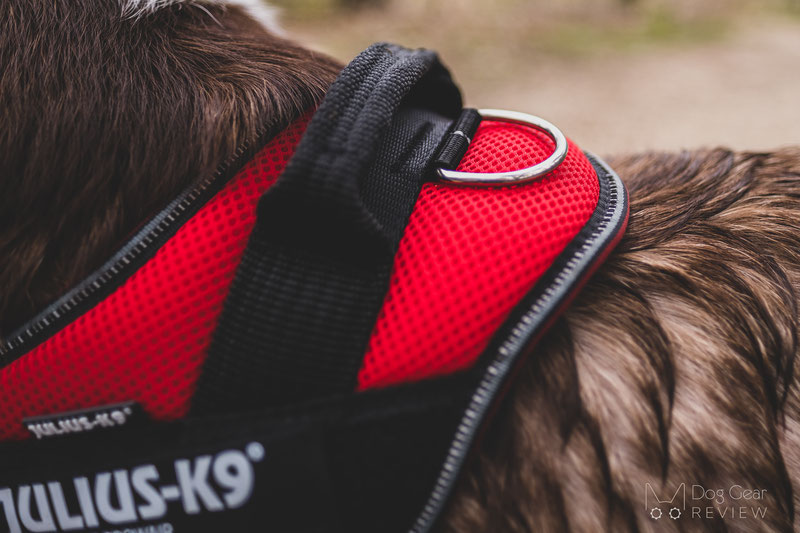
Reflective Vests
Some vests do not provide active cooling but help the dog by reflecting the sun. The advantage is that you can use it anywhere, anytime, with no need to carry extra water or make the dog wet. The reflective vest behaves like a partial shade over the dog, which can be great if they have to wait on the sun during a show/competition or if you are doing long-distance hikes. It also helps to reflect heat radiating from the environment in general, not just from the sun.
While this technology can be beneficial in many situations, it also has clear limitations that are very important to understand to keep the dogs safe! Although they are still called “cooling vests,” these don’t cool the dog down and will not limit them heating up due to exercises; it only slows the temperature increase due to heat radiation. Imagine playing fetch on a hot and humid day in the shade: the dog will still overheat fast, although slower than they would in the sun.
Don’t forget that it doesn’t completely cover the dog either, so their head and neck are still warming up. While technically, you can soak these vests in water to provide active cooling, this is not their primary use case, and they usually don’t retain a significant amount of water.
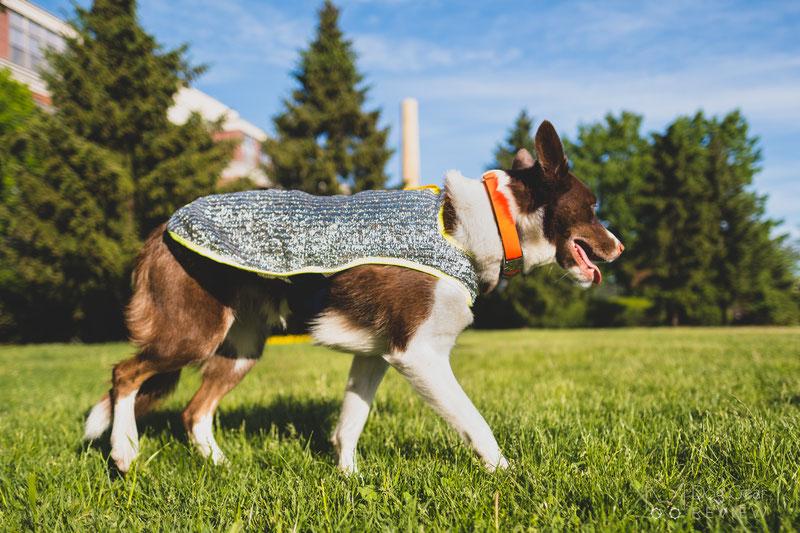
We received the Chillybuddy Cooling Jacket from Cleanrun for testing. This is a well-made but thin jacket that reflects 70% of the infrared radiation on the dog’s back. The outer material is woven synthetic with an aluminized finish (called Aluminet), also used for car shades.
The insulating cotton-mesh layer under the reflective top provides airflow, which is crucial to protect the dog from heat. If you are looking into buying a cheaper Aluminet vest, be sure it does have this underlayer; otherwise, it will just reflect the dog’s body heat and does more harm than good.
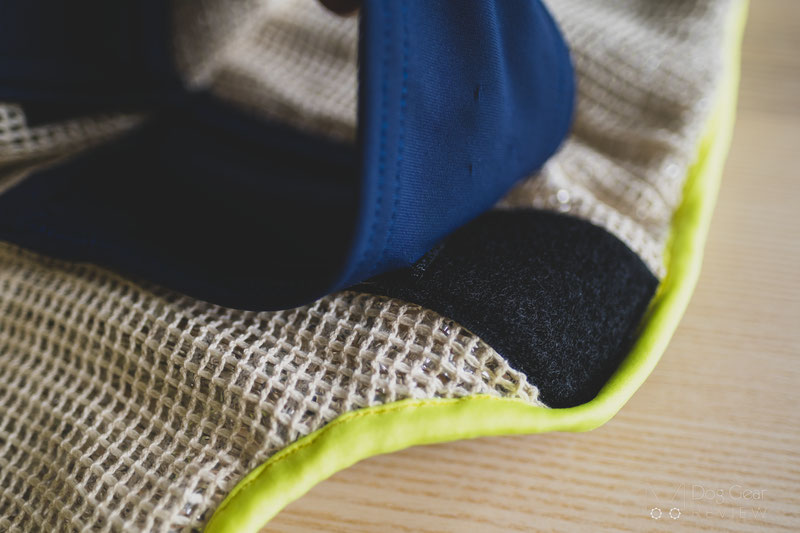
Checking the Chillybuddy Cooling vest with a thermal camera shows the reflecting effect over the coat. Since this isn’t actively cooling the dog, the thermal camera didn’t show a significant surface temperature difference under the vest vs. on other parts of the dog after a half-hour walk on the sun.
If we look closly enough, there is a very small difference under the coat but I expected to see a more significant tempreture difference on the “sunny” vs. “shady” parts. I repeated the same experiment on a second, sunnier but cooler day. Surprisingly, I got the same results. On the other hand, when checking her fur with my palms, her fur under the coat felt slightly less hot - but definitely not cool. While the uncovered hair was radiating heat, the parts under the vest were just simply warm due to warming up on a hot day.
I was very interested to see how another reflective vest compares to this result.
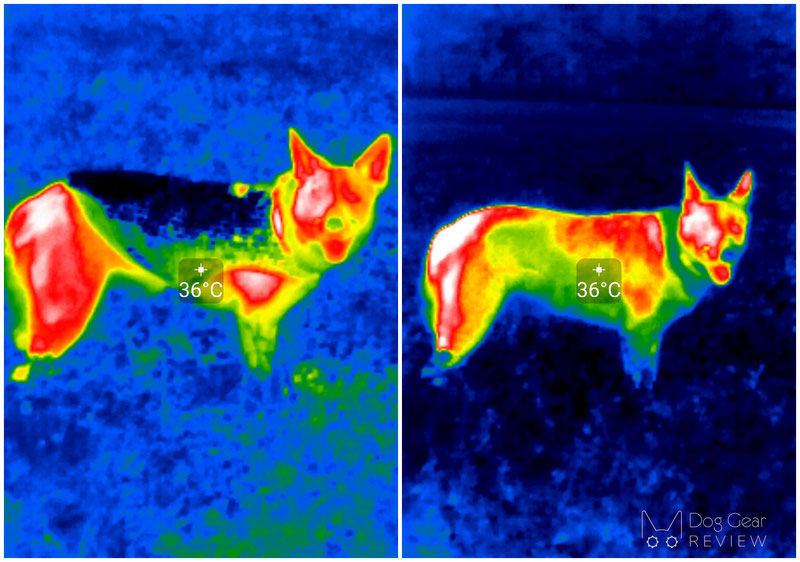
The other reflective vest we tested is the K9 Cool Coat. The K9 Cool Coat also works by blocking the UVA and UVB radiation to slow down the warming process. You can submerge it in water, but it barely retains any, so the added cooling effect will only be short-term.
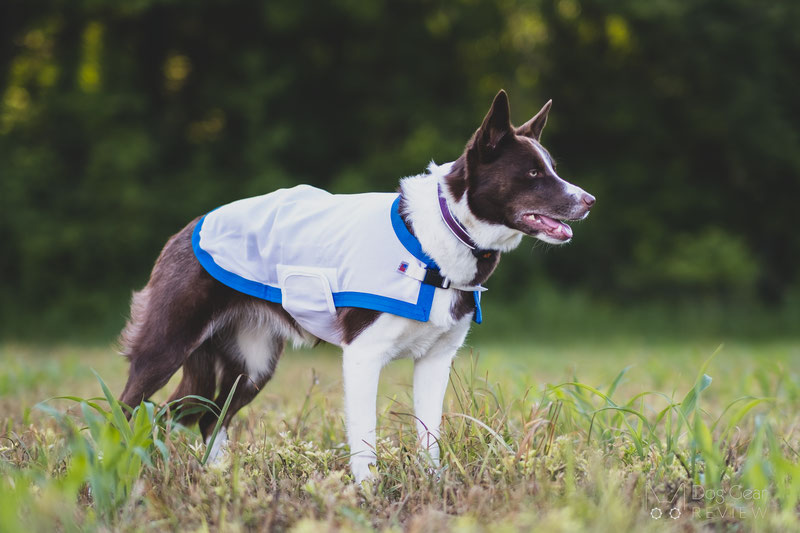
Saratoga Horseworks make this from the same Oasis fabric that’s used for horses. This is a 100% polyester mesh that’s super breathable, feels cool to the touch, and is very durable compared to the sensitive outer material of the Chillybuddy Vest.

When choosing the size, you should try to get one that covers the dog’s back all the way, but for this experiment, this size should be sufficient to see if there is a difference in surface temperature under the coat vs. on Mia’s head/back that wasn’t covered.
Below you see the thermal images with the coat on and when removing the vest after a 30-minute walk in the sun. After repeating this measurement twice, I ended up with the same results that we have seen in the case of the Aluminet vest: wearing the vest does make a slight difference, but it’s not significant. Another aspect worth considering is that the K9 Cool Coat seems to offer better breathability than the Chillybuddy Vest and that the Oasis material is less sensitive than the Aluminet.

It was great to test two different types of reflective vests for this article. The subjective experience was that Mia warmed up slower while wearing them, but radiating heat is just one factor in this. On a hot day, dogs would heat up when moving even in the shade, so I would expect these coats to make a more visible difference on a cooler, but sunny day when a proportionally bigger % of overheating comes from the sun itself.
These vests can be helpful if someone is thru-hiking or when using an evaporation vest is not an option for other reasons, but we can’t press it enough that these are not actual cooling vests. It is essential to know what one can and cannot expect from a reflection vest.
If you want to learn more about the Chillybuddy Cooling Jacket or the Saratoga Horseworks K9 Kooling Coat, you can check out reviews for more information!
Boots
While boots can protect the dog’s paws when they walk on hot or rough surfaces, keep in mind that they also limit their ability to cool down through sweating on their paws which plays a significant role in their temperature regulation. If you decide to use one, choose one that is made of breathable materials!
Putting boots on the dog when they are not truly needed can do way more harm than good. We have a longer article discussing the pros and cons of using boots for summer hikes that you can check out if interested.
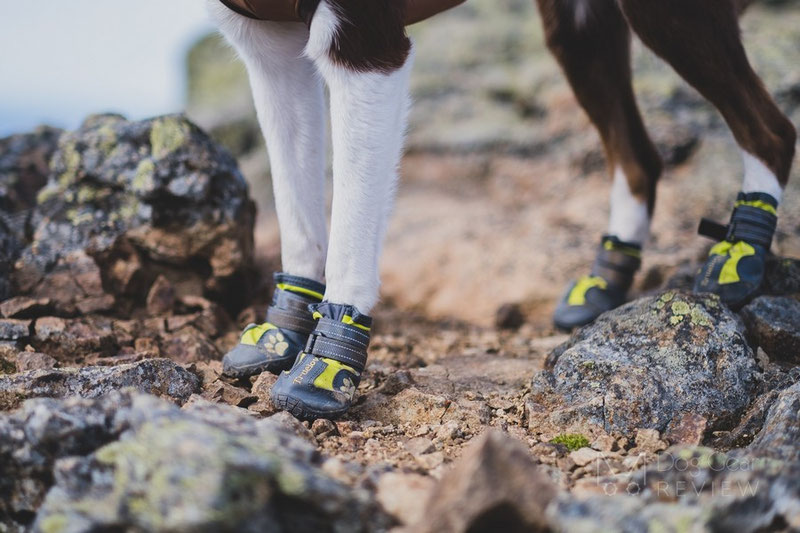
Hydration & Electrolytes
Most people think dogs drink when they need it, and that’s not something that you need to manage. While most dogs work this way, many, like Mia, don’t like to drink (or eat) when hiking or traveling.
Hydration is crucial in all seasons, but especially over the summer. As we discussed in this article repeatedly, the primary way for dogs to cool down is through evaporation while panting (and some on their paws). During this process, they lose a significant amount of water.
I was excited to try the Nulo Hydrate water enhancer because it would make our adventures so much safer if I could convince Mia to drink a reasonable amount when we are out.
As with everything, this also has some risks that you have to keep in mind. Most dogs, especially pet dogs, still drink enough, and they know when they need water, so if there is no reason to force them to drink more, don’t do it. Water intoxication and GDV (Gastric Dilation and Volvulus / bloat / twisted stomach) are very real life-threatening issues that can be a result of drinking a significant amount at once. At the same time, I see many working dogs who are just too excited to stop and drink even if they are getting dehydrated. Adding some flavor to the water to make it more appealing can be a lifesaver for them.
Having a water bowl available at all times - even in the car also helped Mia drink more. If I’m around when water is offered, she is much more interested in doing something and will not drink, but if she is just chilling in the car quietly and the water is there, she will usually have some. The Kennel Gear Bowl is excellent because it securely attaches to most crate doors and it doesn’t rattle, neither can Mia spill it. When I’m done using it, the bowl can easily be removed from the mount that otherwise securely locks it.

Do dogs need electrolytes after more serious exercises?
While I was only looking into water enhancers to add flavor to Mia’s water, most of them also have electrolytes, so I started researching this topic. So far, I only found one research on the subject, so I also reached out and talked to a few vets.
Electrolytes are essential for normal heart and brain functions, delivering oxygen and many other body functions. They can be crucial to administer in case of diarrhea, vomiting, dehydration, or water intoxication. In these situations, always talk to a vet about the exact product and ratios you need.
Besides these use cases, there isn’t any proof that a working dog in good health would benefit from added electrolytes. The reason behind this is that while humans lose salt and electrolytes when sweating (which is why sweat is salty), dogs lose only water while evaporating. They even have different sweat glands on their paws, so as far as I know, they purely lose water there as well. This means that they only need water for hydration unless they get dehydrated, mixing up the electrolyte levels.
So far, I believe the market of electrolyte drinks for pets is mainly based on the assumptions that humans need it, and owners want to provide the same level of care for their pets. If anyone has any sources arguing this, I would be very interested in reading them and learn more on the topic. I will happily update this article if anyone proves me wrong, but after a week of research, I didn’t find any material to support the need for electrolytes for healthy dogs.
Boosting hydration if a dog doesn’t drink enough is still an essential aspect of summer protocol for dogs, but there might not be a need to add anything extra to the water beside the flavor.
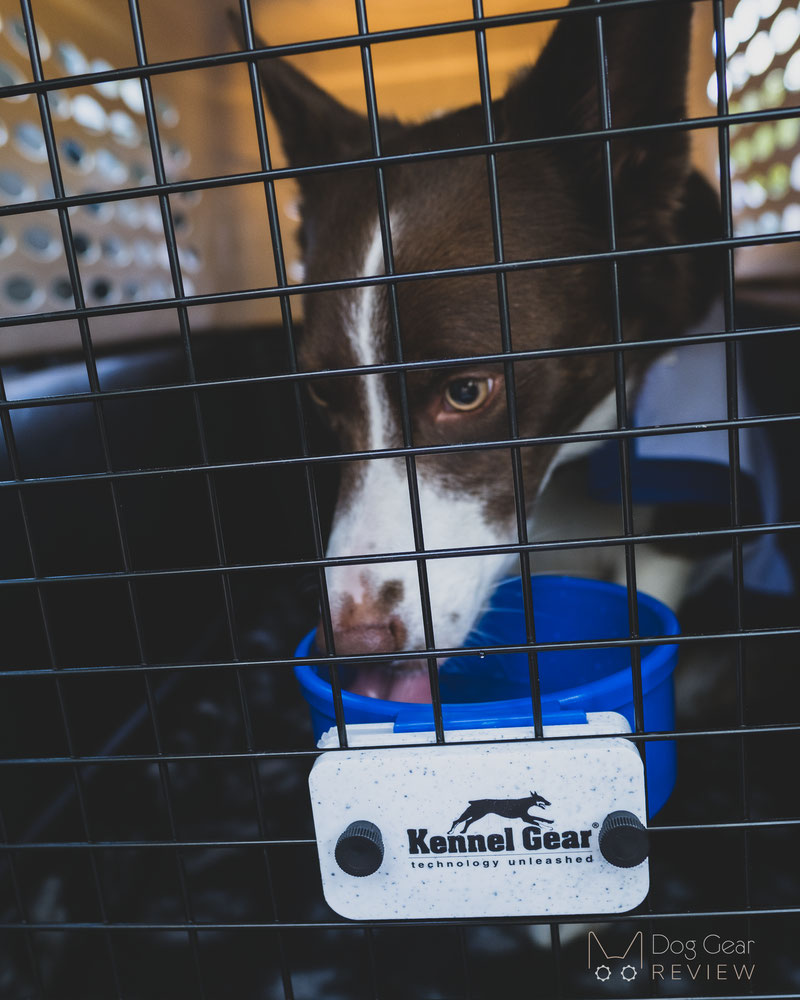
Leaving dogs in the car over the summer
As a general guideline, don’t leave dogs in the car on warm days. This is something that’s repeated on every platform, every summer and still many dogs die in cars every summer. Cars heat up fast, and dogs can overheat quickly, even on a day that doesn’t feel too warm to us.
While I absolutely agree with this, there is a big temperature range when you can bring down the risks of the dog being in the car, and you can make it work if it’s necessary. Necessary doesn’t mean taking the dog with you for a shopping trip just to leave them in the parking lot of the mall.
There are situations when a dog has to wait in the car, and with careful planning, you can make it comfortable for them. Mia is a Search and Rescue Dog In Training. We train twice a week, every week, every season, regardless of the weather. If we would be on an actual call-out, that would probably also happen in unfavorable weather, so we better learn to deal with it during training. We always have someone in the parking lot with the cars, the windows are all down, we can even leave the doors open for created dogs. They always have access to water, and someone is checking on them regularly. I can use the Hydro Triple-Layer Cooling Mat, the Hurtta Cooling Wrap, and the Treva Portable Fan to make Mia comfortable and use the Car Shade if I can’t park entirely in the shade.
Let’s look into how each of these can help!
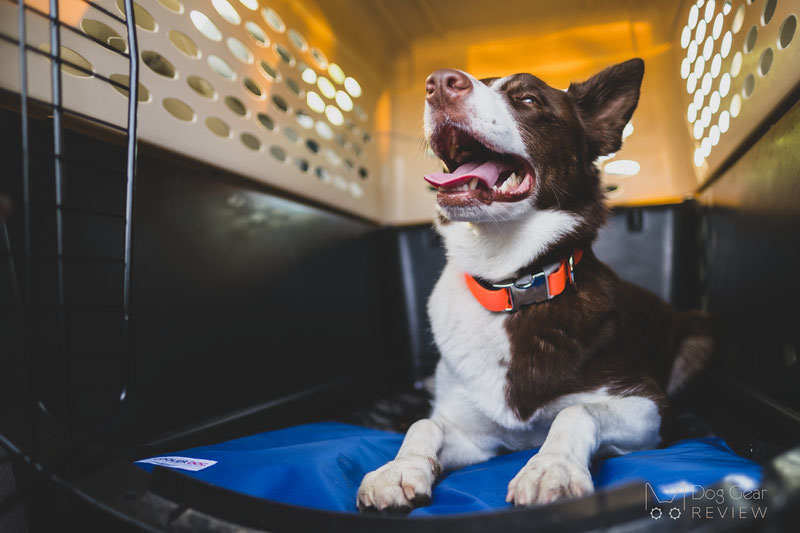
Aluminet Car Shade
The Cool Puppy Aluminet Car Shade from Clean Run reflects 70% of the sun and infrared radiation while still allowing airflow through the mesh-like fabric. This is the same material used for the Chillybuddy Cooling Jacket discussed above.
Without this, the dark roof of the car radiates heat that makes it uncomfortably hot even if the windows are down. Aluminet reflects the heat like a mirror (instead of absorbing it as the car roof would). It is vital to get a shade big enough to cover all the windows to prevent the car from acting like a greenhouse.
Covering the car is the most effective before it heats up. Once the vehicle is hot and radiates heat from every part, it is much harder or sometimes impossible to bring the temperature down by adding the Aluminet shade.
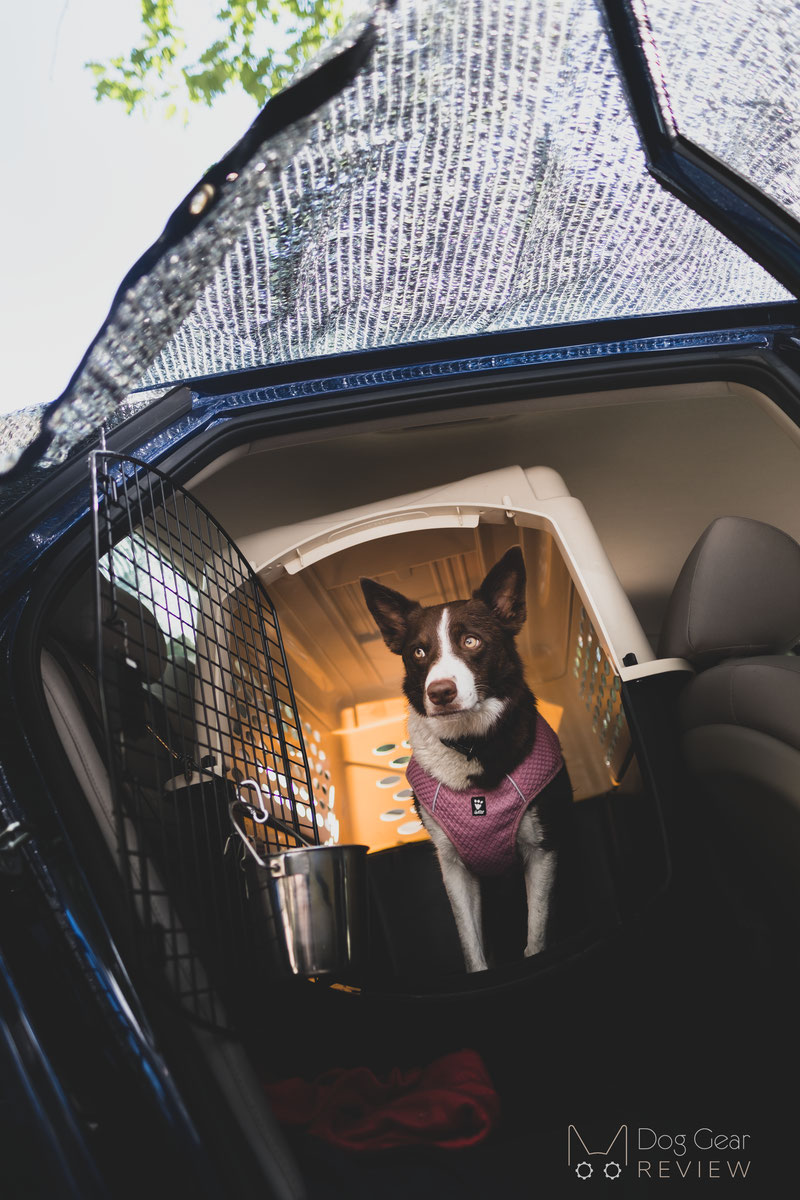
While many others are not, the Cool Puppy Car Shade is UV coated, ensuring that you can use it over many summers. It also has reinforced edges and brass grommets every 12" so they are easy to secure if needed. The only weak point of the shade is the Aluminet mesh itself which can get snagged on something and tear easily if it’s not stored carefully.
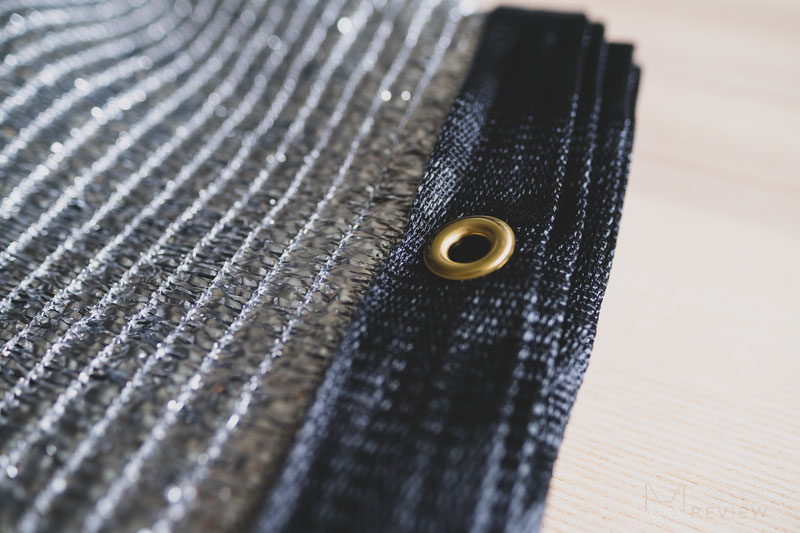
Car Ventilation Lock
The Cool Dog Car Ventilation Lock is another tool that you can utilize to make the car more comfortable on warm days. This allows you to leave the tailgate or the side door partially open while you can still safely lock the vehicle. This provides a much better airflow on the dog’s level (especially in the vehicle’s back) than only leaving the windows open.
This lock behaves like a connector piece between the door latch and the catch inside the car. When you lock the vehicle, as you would normally do, the door locks the same way, but this time it locks to this steel piece. When you want to open it, just unlock the car as you would normally do and use the handle to open the door.
First, we tried the 4" version of this Lock. While that works perfectly with most tailgates, the loop at the end wasn’t long enough to click into the side door’s latch. The 6" version worked perfectly with our side door and provided just the perfect sized opening for plenty of airflow without leaving the door open too much.
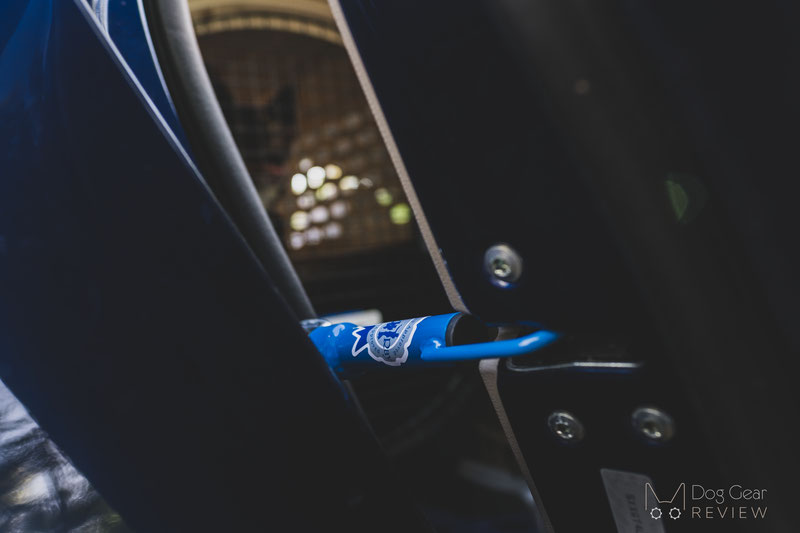
Portable Fans
If you have no option to control the temperature, you can improve the dog’s situation with moving air. However, we have to keep in mind that this works differently for dogs and people.
Humans sweat all over their bodies, so a fan helps with this evaporation process, while dogs have thick hair. When temps are lower (around 70-80F), air circulation helps by pushing the warm air away from them, helping them cool. However, once it gets warmer, air circulation doesn’t matter much (it can actually make it worse) because you blast hot air on them, like using a hairdryer.
You can still utilize a fan on a hot day to blow colder air into or the hot air out of the car/tent or use it to move cold air back from the AC in the car. Another way to utilize the fan is to use it paired with an evaporation vest or soak the dog. If the air is not too humid, having constant airflow over the vest or around a wet dog will speed up evaporation so much that they might get too cold. If you don’t have an evaporation vest and have no option to wet the dog, you can also use a bucket/bag of ice and blow the fan over it.
During the last heatwave, we used the Treva Smart Power fan in the car. It’s an excellent option for us because it can run on four different power sources: from an AC adapter, a 12V car charger adapter, 8 D-cell batteries (not included), or the built-in rechargeable battery. I just charge it before every training because it runs for 5-6 hours with one charge, and I keep the car adapter in the car as a backup. If you use alkaline batteries, they can last up to 56 hours on low speed and up to 37 hours on high speed.

Summary
I hope we introduced all these cooling options enough so you can decide which one can be helpful for your dog in different situations!
The most important takeaway is that none of these will work in all situations for all dogs, and even if they do, they can’t provide 100% protection against overheating. Having some cooling products gives you options to still involve the dog in your adventures over the summer. However, we still need to be careful and prioritize safety above all else.
Disclaimer
Some of the Amazon links in this aricle contain affiliate links, which supports Dog Gear Review if you purchase the product after clicking on it without costing you anything extra. Using affiliate links will never compromise us writing unbiased, honest reviews!
